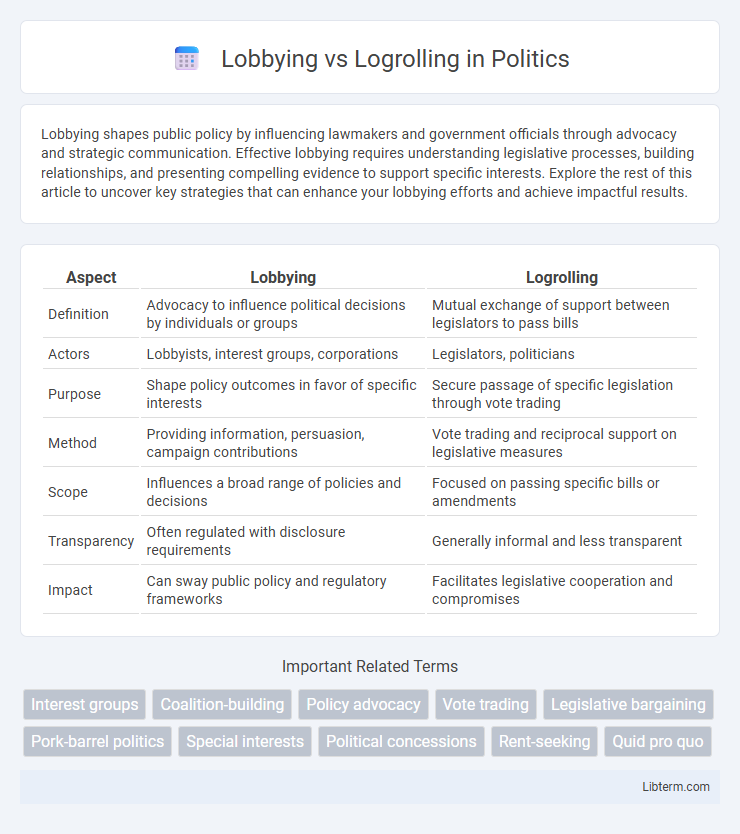Lobbying shapes public policy by influencing lawmakers and government officials through advocacy and strategic communication. Effective lobbying requires understanding legislative processes, building relationships, and presenting compelling evidence to support specific interests. Explore the rest of this article to uncover key strategies that can enhance your lobbying efforts and achieve impactful results.
Table of Comparison
| Aspect | Lobbying | Logrolling |
|---|---|---|
| Definition | Advocacy to influence political decisions by individuals or groups | Mutual exchange of support between legislators to pass bills |
| Actors | Lobbyists, interest groups, corporations | Legislators, politicians |
| Purpose | Shape policy outcomes in favor of specific interests | Secure passage of specific legislation through vote trading |
| Method | Providing information, persuasion, campaign contributions | Vote trading and reciprocal support on legislative measures |
| Scope | Influences a broad range of policies and decisions | Focused on passing specific bills or amendments |
| Transparency | Often regulated with disclosure requirements | Generally informal and less transparent |
| Impact | Can sway public policy and regulatory frameworks | Facilitates legislative cooperation and compromises |
Introduction to Lobbying and Logrolling
Lobbying involves advocating for specific policies or legislation by influencing lawmakers through communication, research, and strategic relationships. Logrolling refers to the practice where legislators exchange mutual support by voting for each other's proposed bills to advance their interests. Both tactics play crucial roles in the legislative process, shaping policy outcomes and political alliances.
Historical Background of Lobbying and Logrolling
Lobbying traces its origins to the 19th century when advocates began influencing American legislators in public spaces such as the lobbies of legislative chambers. Logrolling dates back to early parliamentary practices where legislators exchanged votes to secure mutual benefits, a tactic formalized in U.S. Congress during the 18th and 19th centuries. Both practices have evolved as instrumental mechanisms for policy negotiation and coalition-building in democratic governance.
Key Definitions: Lobbying vs Logrolling
Lobbying involves influencing legislators or government officials to support specific policies or legislation by providing information, advocacy, and persuasion. Logrolling refers to the practice where legislators exchange support for each other's proposed bills or measures to secure mutual benefits or pass legislation. Both are strategic political activities but differ in that lobbying primarily targets external influence, while logrolling is an internal legislative negotiation tactic.
How Lobbying Works in Policy Making
Lobbying influences policy making by engaging interest groups and professional advocates who provide lawmakers with specialized information, research, and recommendations aimed at shaping legislation in favor of specific agendas. Lobbyists utilize direct communication, campaign contributions, and grassroots mobilization to persuade elected officials and bureaucrats to support or oppose bills that affect their clients or causes. By creating strategic alliances and leveraging political capital, lobbying plays a crucial role in crafting policy outcomes that align with the priorities of influential stakeholders.
Mechanisms and Tactics of Logrolling
Logrolling involves legislators exchanging support for each other's proposals, leveraging mutual benefit to secure votes and pass legislation, often through negotiated favoritism and vote trading. This tactic relies on coalition-building and strategic bargaining to align diverse interests, enabling the passage of bills that might not succeed independently. Unlike lobbying, which primarily focuses on external advocacy and influencing policymakers, logrolling occurs internally within legislative bodies as a reciprocal agreement mechanism.
Similarities between Lobbying and Logrolling
Lobbying and logrolling both serve as strategic tools in political processes to influence decision-making and legislation. Each method relies on building alliances and forging compromises among policymakers to secure support for specific interests or bills. Both practices emphasize negotiation and reciprocal agreements, aiming to advance agendas through collective action and mutual benefit.
Major Differences: Lobbying vs Logrolling
Lobbying involves influencing policymakers to pass or block legislation favoring specific interests, typically through direct communication and advocacy by interest groups or professionals. Logrolling refers to a legislative practice where lawmakers exchange support for each other's bills to secure mutual benefit, often leading to coalition-building within legislative bodies. The major difference lies in lobbying being an external influence strategy aimed at lawmakers, whereas logrolling is an internal legislative negotiation tactic among legislators themselves.
Legal and Ethical Implications
Lobbying involves advocating for specific legislation or policy changes through transparent communication with lawmakers, often regulated by legal frameworks such as the Lobbying Disclosure Act to ensure accountability and prevent corruption. Logrolling, the practice of exchanging political favors or votes to pass legislation, raises ethical concerns by potentially undermining democratic decision-making and promoting quid pro quo arrangements that may bypass public interest. Both activities require strict compliance with ethical guidelines and legal statutes to maintain governmental integrity and public trust.
Real-World Examples and Case Studies
Lobbying involves advocacy efforts by interest groups to influence legislative decisions, exemplified by the National Rifle Association's sustained campaign to shape gun control policies in the United States. Logrolling refers to the practice where legislators exchange support for each other's proposals, as seen in the passage of the 1980 Alaska National Interest Lands Conservation Act, where multiple representatives agreed to back each other's bills to secure mutual benefits. Case studies such as the Medicare Prescription Drug, Improvement, and Modernization Act of 2003 highlight how both lobbying pressures and logrolling negotiations jointly shaped significant policy outcomes.
Impact on Democratic Processes and Governance
Lobbying influences democratic processes by enabling interest groups to advocate for specific policies, often increasing political participation but risking unequal access and influence that can skew governance toward special interests. Logrolling, the practice of exchanging political favors or votes, can expedite legislative decision-making but may undermine transparency and accountability by promoting deals that prioritize individual or group benefits over public interest. Both practices significantly impact governance, shaping policy outcomes and the balance between representative democracy and interest group power.
Lobbying Infographic

 libterm.com
libterm.com